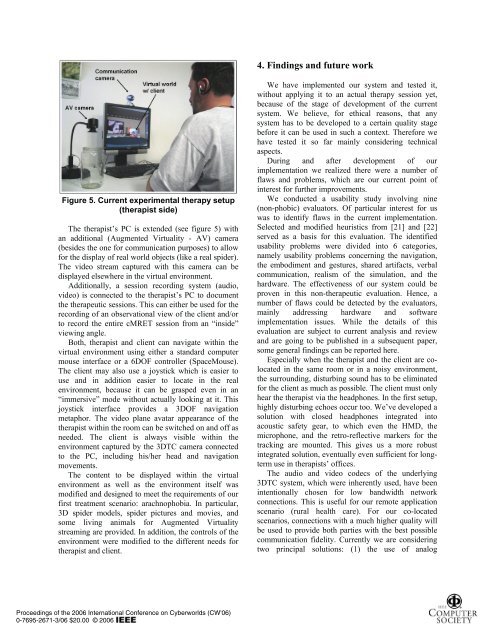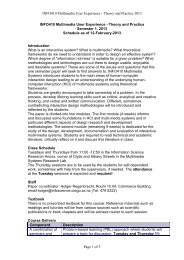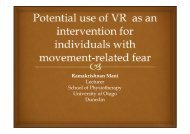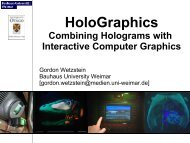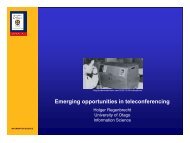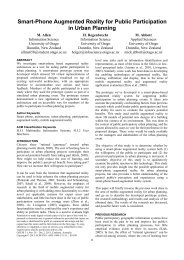4. Findings and future workFigure 5. Current experimental therapy setup(therapist side)The therapist’s PC is extended (see figure 5) withan additional (Augmented Virtuality - AV) camera(besides the one for communication purposes) to allowfor the display of real world objects (like a real spider).The video stream captured with this camera can bedisplayed elsewhere in the virtual environment.Additionally, a session recording system (audio,video) is connected to the therapist’s PC to documentthe therapeutic sessions. This can either be used for therecording of an observational view of the client and/orto record the entire cMRET session from an “inside”viewing angle.Both, therapist and client can navigate within thevirtual environment using either a standard computermouse interface or a 6DOF controller (SpaceMouse).The client may also use a joystick which is easier touse and in addition easier to locate in the realenvironment, because it can be grasped even in an“immersive” mode without actually looking at it. Thisjoystick interface provides a 3DOF navigationmetaphor. The video plane avatar appearance of thetherapist within the room can be switched on and off asneeded. The client is always visible within theenvironment captured by the 3DTC camera connectedto the PC, including his/her head and navigationmovements.The content to be displayed within the virtualenvironment as well as the environment itself wasmodified and designed to meet the requirements of ourfirst treatment scenario: arachnophobia. In particular,3D spider models, spider pictures and movies, andsome living animals for Augmented Virtualitystreaming are provided. In addition, the controls of theenvironment were modified to the different needs fortherapist and client.We have implemented our system and tested it,without applying it to an actual therapy session yet,because of the stage of development of the currentsystem. We believe, for ethical reasons, that anysystem has to be developed to a certain quality stagebefore it can be used in such a context. Therefore wehave tested it so far mainly considering technicalaspects.During and after development of ourimplementation we realized there were a number offlaws and problems, which are our current point ofinterest for further improvements.We conducted a usability study involving nine(non-phobic) evaluators. Of particular interest for uswas to identify flaws in the current implementation.Selected and modified heuristics from [21] and [22]served as a basis for this evaluation. The identifiedusability problems were divided into 6 categories,namely usability problems concerning the navigation,the embodiment and gestures, shared artifacts, verbalcommunication, realism of the simulation, and thehardware. The effectiveness of our system could beproven in this non-therapeutic evaluation. Hence, anumber of flaws could be detected by the evaluators,mainly addressing hardware and softwareimplementation issues. While the details of thisevaluation are subject to current analysis and reviewand are going to be published in a subsequent paper,some general findings can be reported here.Especially when the therapist and the client are colocatedin the same room or in a noisy environment,the surrounding, disturbing sound has to be eliminatedfor the client as much as possible. The client must onlyhear the therapist via the headphones. In the first setup,highly disturbing echoes occur too. We’ve developed asolution with closed headphones integrated intoacoustic safety gear, to which even the HMD, themicrophone, and the retro-reflective markers for thetracking are mounted. This gives us a more robustintegrated solution, eventually even sufficient for longtermuse in therapists’ offices.The audio and video codecs of the underlying3DTC system, which were inherently used, have beenintentionally chosen for low bandwidth networkconnections. This is useful for our remote applicationscenario (rural health care). For our co-locatedscenarios, connections with a much higher quality willbe used to provide both parties with the best possiblecommunication fidelity. Currently we are consideringtwo principal solutions: (1) the use of analogProceedings of the 2006 International Conference on Cyberworlds (CW'06)0-7695-2671-3/06 $20.00 © 2006
connections for audio and video or (2) high-qualityMPEG-4 hardware encoders over a Gigabit network.To date, we are supporting simple (animated)VRML objects only as 3D models, which arecontrolled by the therapist using the cursor keys of hiskeyboard. For a better control of the therapeuticprocess, more interactively controllable objects wouldbe desirable, e.g. the interactive definition of the“walking path” of a spider or starting, stopping, pacechanging of the animation of an animal. In addition theclient should be able to interact with the insects, e.g.by trying to kill them.Currently only one virtual environment is available,but since each client fears different situations, a varietyof virtual environments for the treatment ofarachnophobia is highly desirable. Naturally, not allpossible feared situations can be modeled. We willoffer a set of standardized environments which reflectsthe most common feared situations, such as a garden, akitchen and so on.Also, the authoring process is a manual one at thisstate of the project. While this is sufficient when onlyused in a single or few installations, this part has to beconsidered seriously in the future.With any application of the system in human trialsand eventual therapeutic settings, there is arequirement to address ethical aspects of the projectand to ensure compliance with relevant ethicalstandards and protocols. In a review of ethical issuesfor VR treatment applications [6], it is acknowledgedthat there is a lack of standardized codes of practice inthis area and that local standards need to be developed,based (it is suggested) on appropriately adaptedpublished models such as that proposed by Rizzo et al[18] and the standards promulgated by theInternational Society for Mental Health Online(ISMHO), cited by Heinlen et al. [8]). As it isenvisaged that the project will soon proceed to thesubject-based testing stage, applications will need to bemade to the university ethics committee, and possiblythe regional (Ministry of Health) ethics committee, andapproval obtained before the study can proceed. It isour intention that the work envisaged will adhere to“best practice” guidelines such as those suggested byRizzo et al. and those of the ISMHO, and will alsomeet the standards established by relevant professionalethics codes (e.g. the American PsychologicalAssociation’s Ethical Code and the Code of Ethics forPsychologists working in Aotearoa/New Zealand,2002). Even more ethical issues can be expected whenusing our approach in a remote scenario. Therefore ourstarting point in using the system for the actualtreatment will be for co-located situations in thetherapist’s office.Finally, the entire system has to become very robustand extensively tested (in particular empirically)before we can deploy it for a wider use.After the completion of this first system to an extentwhich allows for everyday therapeutic work, we will(1) target more treatment scenarios, like fear ofheights, fear of flying, and some specific disorders, (2)test the advantages of Augmented Reality exposuretherapy (technology already provided with our systemto a certain extent), (3) develop guidelines for the useof cMRET for researchers, developers, andpractitioners, and (4) apply and test our system in aremote collaboration setting over an actual distance ina real case scenario.5. AcknowledgmentsWe would like to thank Joerg Hauber, Claudia Ott, andMichael T. Wagner for their help in implementing oursystem as well as Graeme Roxburgh and Brendon Slyfor helping us with the manuscript and the threeanonymous reviewers for their very valuablecomments.Our nine heuristic usability evaluators gave us veryconstructive feedback on the flaws and possibilities ofour current implementation.In addition, we would like to thank DaimlerChryslerResearch and Technology for supporting our work.6. References[1] Alcañiz, M., Botella, C., Baños, R., Perpiña, C., Rey, B.,Lozano, J.A., Guillén, V., Barrera, F., & Gil, J.A. (2003).Internet-Based Telehealth System for the Treatment ofAgoraphobia. Cyberpsychology & Behavior, 6(4).[2] AliceStreet, Online product description.http://www.alicestreet.com, last accessed 17/03/06[3] Anderson, P., Rothbaum, B.O., & Hodges, L.E. (2003).Virtual Reality Exposure in the Treatment of Social Anxiety.Cognitive and Behavioral Practice 10, 240 – 247.[4] Carlin, A.S., Hoffman, H.G., & Weghorst, S. (1997).Virtual reality and tactile augmentation in the treatment ofspider phobia: a case report. Behavior Research and Therapy,35:153–158.[5] Choi, Y.H., Jang, D.P., Ku, J.H., Shin, M.B., & Kim, S.I.(2001). Short-Term Treatment of Acrophobia with VirtualReality Therapy (VRT): A Case Report. Cyberpsychology &Behavior, 4(3)Proceedings of the 2006 International Conference on Cyberworlds (CW'06)0-7695-2671-3/06 $20.00 © 2006


